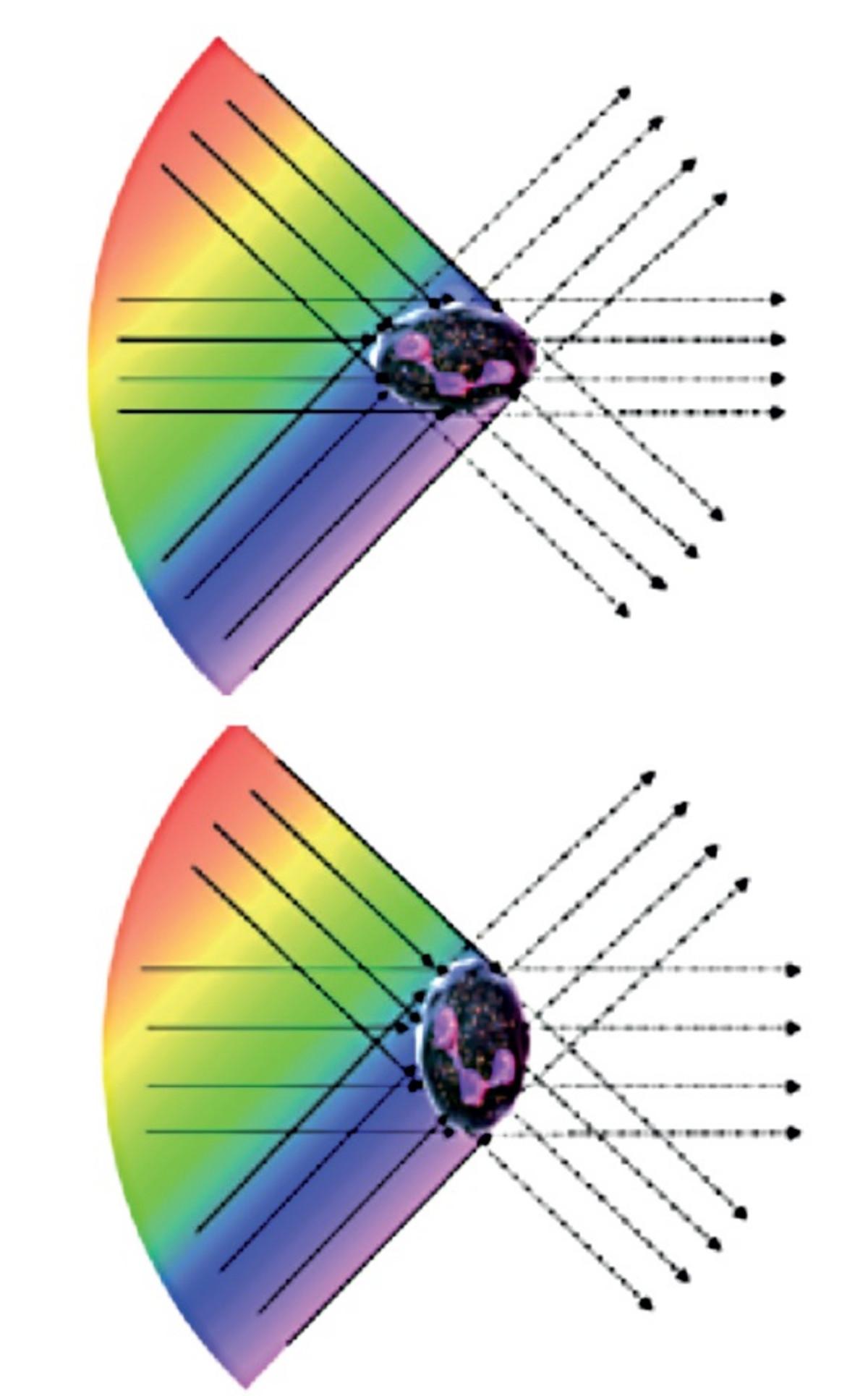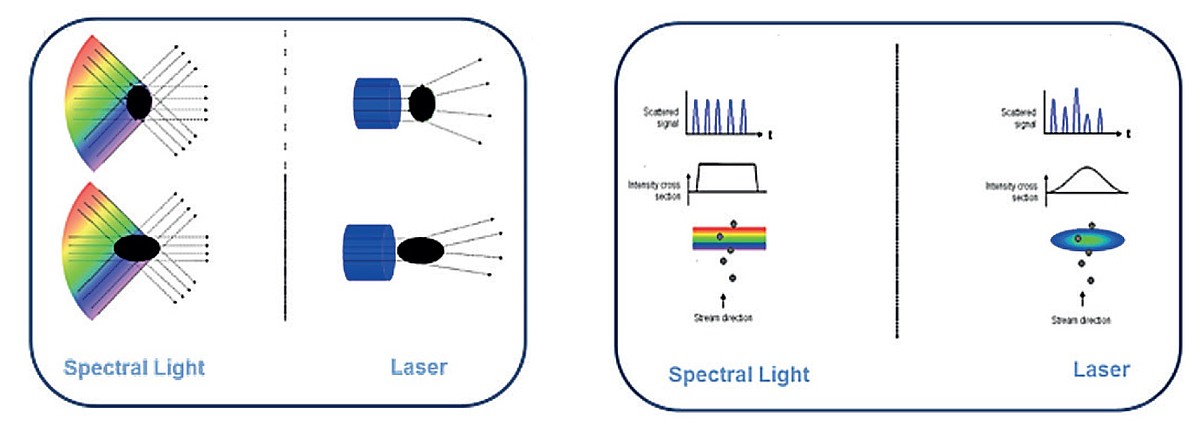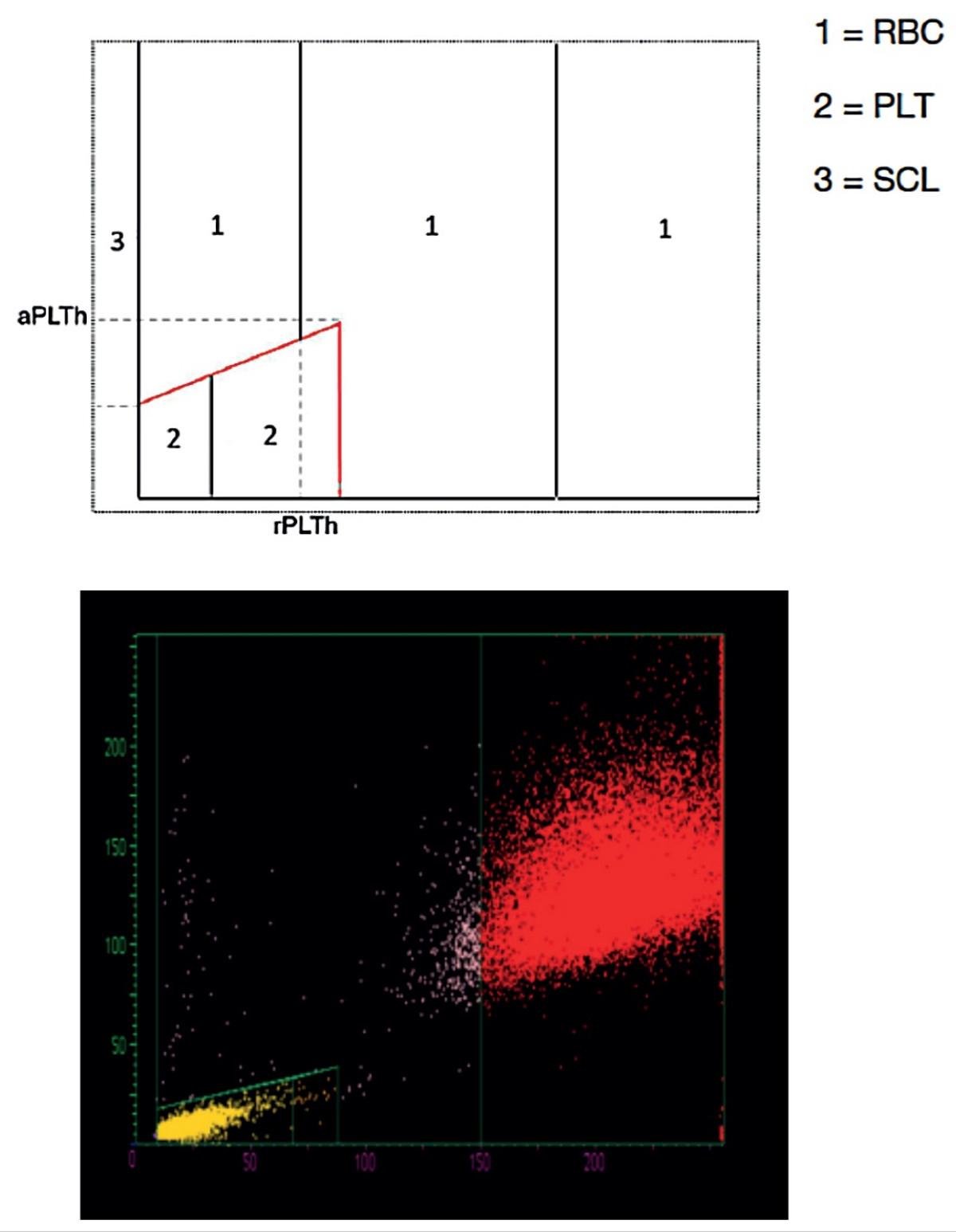

The Double Hydrodynamic Sequential System (DHSS) technology is the technology from HORIBA Medical. Its significance is to ensure a linear flow of cells through electrical impedance method and optical measurement which helps in well differentiation of WBCs sub-population, along with Platelets. Double Hydrodynamic focusing is a technique used to provide accurate results from flow cytometer. DHSS helps in approach to blood analysis, specialized.
DHSS_figure1_technology_image_HORIBA Medical
1. The cells go through the aperture one by one (① in Figure 1) to be counted and measured by electrical current (impedance changes). This is the resistive measurement for cell volume.
2. Then each one crosses the light beam that arrives at a 0° angle (➁ in Figure1) determining the cells complexity.
• Some part of the light is absorbed by the cell content,
• Major part is deviated by the cell structure (scattered light),
• Rest of the part passes through or around the cell.
HORIBA Medical analyzers uses a combination of optical measurement and electrical impedance for counting & analyzing the cells as they pass through a micro aperture electrode system. Electrode impulse is then used to count the number of cells, measure the size and distribution of leucocytes, erythrocytes and thrombocytes.
DHSS_figure2_technology_image_HORIBA Medical
HORIBA Medical special reagent Nucediff lyse RBC and stabilizes the leucocytes (WBC) in their native forms. Each cell is then measured both in optical extinction (internal structure) and resistivity (volume) which allows total nucleated cells count and differential count of lymphocytes, monocytes, neutrophils, eosinophils, atypical lymphocytes, immature populations and erythroblasts.
blood cells_technology_image_HORIBA Medical
The LMNE detection principle is based on the Double Hydrodynamic Sequential System (DHSS) flowcytometry. Two characteristics for each cell passing through this system are determined: volume and optical light extinction.
Figure 3: 1= Lymphocytes 2= Monocytes 3= Neutrophils 4= Eosinophils 5= IML (Immature Lymphocytic cells) 6= IMM (Immature Monocytic cells) 7= IMG (Immature Granulocytic cells) 8= Erythroblasts or Platelet aggregates 9= Background Noise Low 10= Background Noise High
From the extinction and resistive measurements of the leukocytes, a matrix is developed with cell volumes on the X-axis and extinction on the Y-axis. Study of the matrix image allows a clear differentiation of leukocyte sub populations.
The cell population thresholds (some of them mobiles and the others fixed) give the normal limits for the normal leukocyte morphologies. Changes in the morphology of a specific population is indicated on the matrix by a shift in the corresponding population.
The fixed thresholds (Figure 3) appear in black and the mobile thresholds appear in red in the picture below. The blue thresholds follow the red ones when adjusting the matrix. The matrix enable the calculation of the leukocytes population percentage following this figure:
Erythroblasts are immature red blood cells with a nucleus. The flow-cytometer detects the nuclei of the NRBC cells liberated after the Nucediff lyses their membranes. Because of their small size and low absorbency, they are placed on the left part of the lymphocyte population on the matrix (box #8 of Figure 3). In this zone, we can also find platelet aggregates. The instrument can differentiate them from the erythroblasts thanks to specific algorithms. In all cases, NRBC and platelet aggregates are not included in WBC counts.
DHSS_figure4_technology_image_HORIBA Medical
In the HORIBA Medical analysers, the extinction measurement is made using low coherence optical source. The low coherence optical source is characterized by the different spectral and spatial components of the light beam. This measurement reveals the morphology of the different cells organelles on the one hand, and intra-cytoplasmic characteristics on the other hand. The high numeric aperture of the light beam allows the observation of cells.
This measurement is less sensitive to cell anisotropy, and its position or orientation in the beam (Figure 4), and gives information depending on the intrinsic characteristics of the cell.
In polychromatic light using a beam of low spatial coherence (divergent beam), the measurement is less sensitive to the position or orientation of the cell in the beam.
Giving the complexity of the structure and morphology of the leukocytes, the identification and counting method combining cytochemistry and low coherent light measurement (low coherence illumination) proves to be more discriminating and more robust compared to laser methods.
DHSS_spectral light_laser_technology_image_HORIBA Medical
| Laser | Low Coherent Light Lamp | |
| Advantage | High power in flow cell (90% of light source). Suitable for fluorescence. | Flatness of beam intensity profile. Very low noise (high frequency). |
| Limitation | Noisy light, speckle, Difficult to use for precise volume measurement. Gaussian light shape. | Low efficiency (0.0004%). Electric consumption, themal emission. Not suitable for fluorescence. |
The optical measurement done on Yumizen analyzers allow to provide more accurate information on the volume, nucleo-cytoplasmic ratio and internal structure of each cell, and this robustness is particularly useful for abnormalities identifications.
Similar to WBC analysis, Platelets are counted with utilization of Double Hydrodynamic sequential system when samples are processed on PLT Ox mode. PLT Ox mode differentiate Platelet from RBC population on the basis of refractive index. The measurement principle is similar to the LMNE one.
1. After the dilution, the solution is transferred from the chamber to the optical bench using an aspiration, before being analyzed in the measuring chamber. The dilution is sleeved with a double hydrodynamic sleeving and passes through the aperture of the LMNE flowcell and the optical window. Each cell is measured both in resistivity (volume) and absorbency (cytochemistry).
2. From these measurements, a matrix is drawn up with volumes on the X-Axis and optical extinction on the Y-Axis.
Figure 6: PLTOx matrix representations
This parameter corresponds to the percentage of platelets relative to the RBC identified on the matrix, multiplied by the count of RBC identified in the chamber. No need to calibrate this parameter since it relies on the calibration of the RBC. At the same time, the instrument runs a RBC/PLT Low Value cycle.
Hydrodynamic focusing uses sheath flow to control the sample rate inside the aperture and direct the sample flow along the central axis of the aperture. Here in HORIBA Medical Double Hydrodynamic Sequential System is used to prevent edge effects from altering the results and helps to align particles to the same orientation.
The presence of stronger electric gradients near the edges of an electric field than at the center can influence accuracy, it can distort the size of the electrical pulse, resulting in an overestimation of a particle’s size. This occurs when particle pass through the micro-aperture at different positions. It is further complicated by the particle’s orientation through the aperture.
The use of DHSS avoids many of the potential problems inherent in a aperture system. The sample stream is surrounded by a sheath fluid, as it passes through the central axis of the aperture. Laminar flow allows the central sample stream to narrow sufficiently to separate and align the cells into single file for passage through the sensing zone. The outer sheath fluid eliminates recirculation of cells back into the sensing zone.
1. Kachel V; Electrical Resistance Pulse sizing: Coulter sizing. Flow cytometry and Sorting. Second Edition, T. Willy & Sons, 1990; p 45-80.
2. Al Quddus N, moussa W.A and Bhattacharjee S., Motion of a spherical particle in a cylindrical channel using arbitrary Lanrangian-Eulerian method., J. Colloid and Interface Science, 2008; 317:620-630.
3. European patent EP 0 425 381, Apparatus for counting and determination of at least one leucocyte-subpopulation. Filing date: 25 october 1990; Lefevre D; Champseix H.; Champseix S.
4. BLOOD CELLS A practical Guide, Barbara J.Bain, Fourth edition (2006) Blackwell Publishing. Barbara J.Bain Professor of Diagnostic Haematology St Mary’s Hospital Campus of Imperial College Faculty of Medicine, London and Honorary Consultant Haematologist, St Mary’s Hospital London.
5. Optics of Biological Particles, series II: mathematics, Physics and Chemistry – Vol.238 NATO Science Series; Alfons Hoestra University of Amsterdam, The Netherlands. Valeri Maltsev Institute of Chemical Kinetics and Combustion, Novosibirsk, Russia. Gorden Videen Army Research Laboratory, Adelphi, MD, USA, University of Amsterdam, The Netherlands.
6. Lasers and Current Optical Techniques in Biology, Comprehensive series in photochemistry and photobiology- volume 4 RS.C , Giuseppe Palumbo Dipartemento di Biologia e Patologia Cellulare e Molecolare”L.Califano”, Università di Napoli “Federico II”, Napoli, Italia. Riccardo Pratesi Dipartimento di Fisica, Università di Firenze, Sesto Fiorentino (Fi), Italia.
7. Blood Cell Biology, Optics and Related Technologies, Readout HORIBA Technical Reports, English edition N°8, august 2004 . Philippe Nerin, Research Director Horiba Medical, PhD, Didier Lefèvre, R&D Department
8. Determination of volume, shape and refractive index of individual blood platelets; I.V. Kolesnikovaa,b, S.V. Potapovb, M. A. Yurkinb,c, A.G. Hoekstrac , V.P. Maltseva,b and K.A. Semyanovb, a Novosibirsk State University, Pirogova Str. 2, 630090, Novosibirsk, Russia b Institute of Chemical Kinetics and Combustion, Siberian Branch of the Russian Academy of Sciences, Institutskaya Str. 3, 630090, Novosibirsk, Russia c Faculty of Science, Section Computational Science, of the University of Amsterdam, Kruislaan 403, 1098 SJ, Amsterdam, The Netherlands.
9. UNDERSTANDING CONJUGATE PLANES AND KÖHLER ILLUMINATION Michael W. Davidson and Thomas J. Fellers; National High Magnetic Field Laboratory, The Florida State University, 1800 E. Paul Dirac Dr., Tallahassee, Florida 32306.
Hematology and ESR Analyzer
Hematology Analyzer
Hematology Analyzer
Hematology Analyzer
Hematology Analyzer
Hematology Analyzer
Hematology Analyzer
Hematology Analyzer
Do you have any questions or requests? Use this form to contact our specialists.






